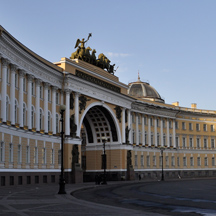
The European Biennial of Contemporary Art
28 June 31 October 2014
St. Petersburg, Russia The State Hermitage Museum
History of Manifesta
Manifesta 1 (1996) was held across 16 museums and 36 public spaces around the Museumpark in the centre of Rotterdam, curated by Katalyn Neray (Budapest), Rosa Martínez (Barcelona), Viktor Misiano (Moscow), Andrew Renton (London), and Hans Ulrich Obrist (London).
Manifesta 2 (1998) took place in five museums and art venues, and public spaces in Luxembourg. It was curated by Robert Fleck (Düsseldorf), Maria Lind (Stockholm), and Barbara Vanderlinden (Brussels). Alongside the works of 47 artists, an art mediation program gave 30 young people from all over Europe the opportunity to contribute to the event.
Manifesta 3 (2000), curated by Francesco Bonami (New York/Turin), Ole Bouman (Rotterdam/Shenzhen), Mária Hlavajová (Amsterdam/Utrecht), and Kathrin Rhomberg (Berlin/Vienna) presented artists, artists’ collectives, urban planners and architects over three main venues in Ljubljana.
Manifesta 4 (2002), held in Frankfurt/Main, was curated by Iara Boubnova (Sofia), Nuria Enguita Mayo (Valencia), and Stéphanie Moisdon Trembley (Paris). Situated amongst the physical realities of the city, it was also experienced through radio and television broadcasting, and had a strong online presence.
Also in 2002, Manifesta initiated its ongoing “Coffee Break” event, as a recurring public meeting that serves as an active tool to discuss the concept of Manifesta within a larger critical context.
In 2003, the Manifesta Journal, an international journal focusing on the practices and theories of contemporary curating, was founded.
Manifesta 5 (2004), curated by Massimiliano Gioni (Milan/New York), Marta Kuzma (Venice/Stockholm) was held in Donostia-San Sebastián and engaged with the region’s strong Basque identity, representing a shift in Manifesta’s identification with an “East-West” discourse, towards achieving an equally strong “North-South” balance in its activities.
Manifesta’s planned, 6th edition, was to take the form of an art school in Nicosia, Cyprus. Its cancellation deepened Manifesta’s awareness of the sensitivities of engaging with local political contexts and contested regions.
Manifesta 7 (2008) in Trento, curated by Adam Budak (Washington), Anselm Franke (Berlin), Hila Peleg (Berlin), and the Raqs Media Collective (New Delhi), focused not only on one city, but on an entire regional territory.
Manifesta 8 (2010) took place in the host cities of Murcia and Cartagena in southeast Spain, curated by three independent curatorial collectives: Alexandria Contemporary Arts Forum (ACAF); the Chamber of Public Secrets (CPS), with members based in the UK, Egypt, Italy, Lebanon, and Denmark; and tranzit.org, a group of autonomous initiatives in Austria, the Czech Republic, Hungary, Slovakia, and Romania. The location inspired the Biennial’s sub-theme of a dialogue with northern Africa.
Manifesta 9 (2012) was held at the former Waterschei mine in Genk, Belgium, curated by Cuauhtémoc Medina (Mexico City), in association with Katerina Gregos (Brussels), and Dawn Ades (London). In this recent edition, the Biennial presented a remarkable collection of historical artworks alongside selected contemporary positions, in addition to exploring the rich mining heritage of the region.






